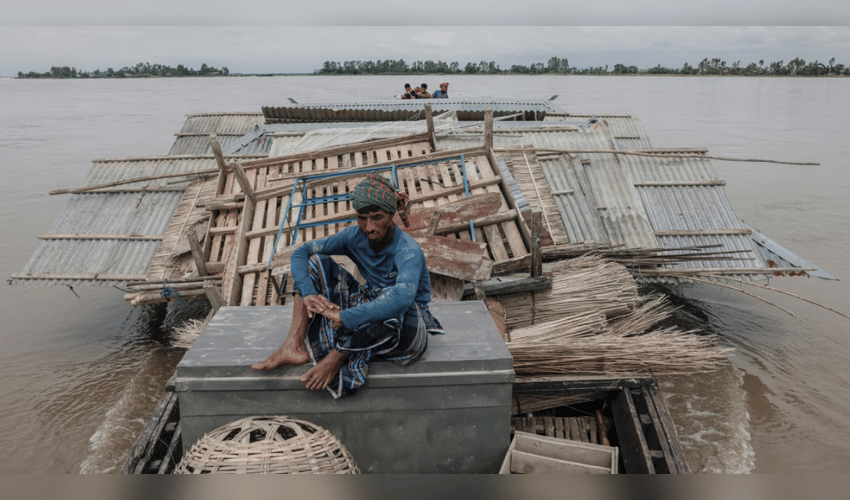Asia In News
When the rivers consume the land: Bangladesh's unending struggle against erosion

On a grey morning, Nurun Nabi loads bamboo poles and tin sheets onto a small wooden boat. His home, built just a year ago on a fragile island in the Brahmaputra River, is about to be devoured by the rising waters once again. It is the second time in a year that the 50-year-old farmer and father of four has been forced to move. “The river comes closer every day,” Nabi says, his voice filled with fatigue. “We were born to struggle. Our suffering never ends. I’ve lost count of how many times the river has taken my home.”
With his rice and lentil fields already gone, washed away by the Brahmaputra’s advancing current, Nabi has no option but to move to another char — a temporary island formed from river sediment. The Brahmaputra, originating in the Himalayas and passing through China and India before reaching Bangladesh, continues its relentless erosion. “I don’t know what will happen in the new place,” he says, gazing at the vast brown water. “If I’m lucky, we’ll stay for a few years. If not, maybe just a month. That’s our life.”
Each year, hundreds of families in northern Bangladesh’s Kurigram district face the same fate. As riverbanks collapse, people lose their homes, land, crops, and livestock. Once a lifeline, the Brahmaputra, Teesta, and Dharla rivers have become forces of destruction, eroding land faster than ever. The chars — shifting, sandy islands scattered across the northern plains — are among the most unstable parts of the country. Families rebuild endlessly, only for the river to reclaim everything.
“The water gives no warning,” says 70-year-old farmer Habibur Rahman, who has lived on several chars. “You go to sleep, and by morning the riverbank has moved. You wake up with nothing. There’s no peace in our lives.” As global attention turns to Brazil for the UN climate summit, Bangladesh’s struggle stands as a grim reminder of the realities faced by vulnerable nations. The country is often praised for its resilience — building embankments, developing flood warnings, and promoting community-based adaptation — but without stronger international support and financing, those efforts cannot hold back the tide.
“People here are paying for emissions they never produced,” says Ainun Nishat, a water and climate expert. “If COP30 is to mean anything, it must provide real funding for loss and damage, and help nations like ours protect lives and land before it’s too late.” What is happening in Kurigram, scientists say, is climate change in plain sight. The rapid melting of Himalayan glaciers feeding the Brahmaputra and Teesta rivers has accelerated dramatically. “Glacial melt is nearly double what it was in the 1990s,” Nishat explains. “More meltwater means rivers that are already swollen are flooding even more.”
At the same time, monsoons have grown erratic — arriving early, lasting longer, and unleashing sudden, intense downpours. “The rhythm of the seasons has changed,” Nishat says. “When it rains, it rains too much. When it stops, droughts follow. This instability worsens floods and erosion.” Although Bangladesh contributes less than 0.5% of global carbon emissions, it suffers some of the worst climate impacts. The World Bank estimates that by 2050, one in seven Bangladeshis could be displaced by climate-related disasters. For 50-year-old father of seven, Kosim Uddin, losing homes to the river has become routine. “The river has taken my home maybe 30 or 35 times — I’ve stopped counting,” he says, eyes fixed on the flowing water. “Every time we rebuild, it comes again. But where can we go? Everywhere is water now.”
Women bear the heaviest burden of this constant displacement. Shahina Begum, 30, recalls cooking for her family while standing waist-deep in floodwater last year. “We’ve moved six times in ten years,” she says. “Every time we start over, the river takes everything back.” Each move brings new hardship. “It’s even harder for women and young girls,” she adds. “We have to find dry ground, cook, care for children — and we have no privacy or safety.”
On Kheyar Alga Char, about 300 families have managed to stay put for three years, thanks to geobags — large sand-filled sacks installed along the riverbanks to reduce erosion. “These geobags have changed our lives,” says 39-year-old Johurul Islam, who lost his home more than ten times before settling here. “For three years, the river hasn’t taken our land. For the first time, I feel some hope.” Local organizations are also helping to build raised villages — clusters of homes elevated above flood levels. Standing by the reinforced riverbank, Islam looks out at the water, a faint smile on his face. Around him, children play on firm ground, their laughter carried by the wind. “Maybe the river will come again someday,” he says. “But this time, we’ll be ready. For now, the land is holding — and so are we.”



